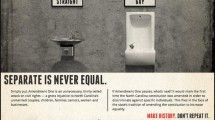Abstract
It is a commonplace of discussion about the impact of visual media, whether visual images in print, televisual images or the images of the internet, to claim that it functions irrationally. This paper argues against that claim. First, the assumptions about the connection between rationality and linear, written, unemotional prose are unjustified. Secondly, using analytic techniques analogous to those used in identifying argumentation in verbal text, is possible to discern arguments in visual text, in particular in image based advertisements.
Similar content being viewed by others
REFERENCES
Barthes, R.: 1973, Mythologies, A. Lavers (trans.), Paladin, London.
Barthes, R.: 1977, Image, Music, Text, S. Heath (trans.), Fontana, London.
Baudrillard, J.: 1983, Simulations, P. Foss, P. Patton and P. Beitchman (trans.), Semiotext(e), New York.
Birdsell, D. S. and L. Groake: 1996, ‘Toward a Theory of Visual Argument’, Argumentation and Advocacy 33(1), 1-10.
Blair, J. A.: 1996, ‘The Possibility and Actuality of Visual Argument’, Argumentation and Advocacy 33(1), 23-39.
Chomsky, N.: 1957, Syntactic Structures, Mouton, The Hague.
Corbett, E.: 1990, Classical Rhetoric for the Modern Student, OUP, Oxford.
Davidson, D.: 1984, Inquiries into Truth and Interpretation, OUP, Oxford.
Eemeren, F. von and R. Grootendorst: 1992, Argumentation, Communication and Fallacies A Pragma-Dialectical Perspective, Lawrence Erlbaum, New Jersey.
Eisenstein, E.: 1983, The Printing Revolution in Early Modern Europe, Cambridge University Press Cambridge, Mass.
Fleming, D.: 1996, ‘Can Pictures Be Arguments’, Argumentation and Advocacy 33(1), 11-22.
Frege, G.: 1952, Translations from the Philosophical Writings of Gottlob Frege, P. Geach and M Black (trans.), Blackwell, Oxford.
Grice, H. P.: 1975, ‘The Logic of Conversation’, in P. Cole and J. Morgan (ed.), Syntax and Semantics, Academic Press, New York.
Groarke, L.: 1996, ‘Logic, Art and Argument’, Informal Logic 18(2, 3), 105-129.
Groarke, L.: 1999, ‘The Pragma-Dialectics of Visual Argument’, in F. van Eemeren, R. Grootendorst, J. A. Blair and C. A. Willard (eds.), Proceedings of the Fourth International Society for the Study of Argumentation, Kluwer, Amsterdam, pp. 276-280.
Halliday, M. A. K.: 1985, An Introduction to Functional Grammar, Edward Arnold, London.
Johnson, M.: 1989, The Body in the Mind: the Bodily Basis of Meaning, Imagination and Reason, University of Chicago Press, Chicago.
Johnson, R. H. and J. A. Blair: 1994, Logical Self Defence, McGraw Hill, New York.
Kress, G. and T. van Leewen: 1996, Reading Images: The Grammar of Visual Design, Routledge, London.
Lakoff, G. and M. Johnson: 1980, Metaphors We Live By, University of Chicago Press, Chicago.
Lewis, D.: 1969, Convention, Harvard University Press, Boston.
Mitchell, W. J. T.: 1994, Picture Theory, University of Chicago Press, Chicago.
The News: 5/10/99, Citibank Ad, Mexico City.
Pettit, P.: 1977, The Concept of Structuralism: A Critical Analysis, University of California Press, Berkeley.
Plato: 1970, The Republic, Benjamin Jowett Sphere (trans.), London.
Poster, M.: 1994, ‘The Mode of Information and Post-Modernity’, in Crowley Mitchell (eds.), Communication Theory Today Polity, Cambridge, pp. 173-192.
Postman, N.: 1985, Amusing Ourselves to Death: Public Discourse in the Age of Show Business, Penguin, New York.
Postman, N.: 1993, Technopoly, Penguin, New York.
Rushkoff, D.: 1997, Children of Chaos > *[Surviving the end of the World as we Know it], Flamingo, New York.
Searle, J.: 1969, Speech Acts, Cambridge University Press, Cambridge.
Sartori, G.: 1998, Homo Videns, Taurus, Madrid.
Turkle, S.: 1995, Life on the Screen, Simon and Schuster, New York.
Williamson, J.: 1981, Decoding Advertisements, Marion Boyars, New York.
Wittgenstein, L.: 1953, Philosophical Investigations, Elizabeth Anscombe (trans.), Blackwell, Oxford.
Author information
Authors and Affiliations
Rights and permissions
About this article
Cite this article
Slade, C. Seeing Reasons: Visual Argumentation in Advertisements. Argumentation 17, 145–160 (2003). https://doi.org/10.1023/A:1024025114369
Issue Date:
DOI: https://doi.org/10.1023/A:1024025114369




